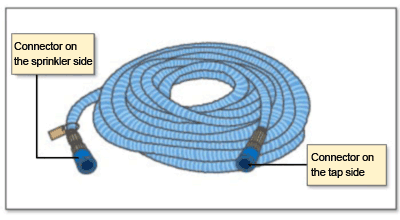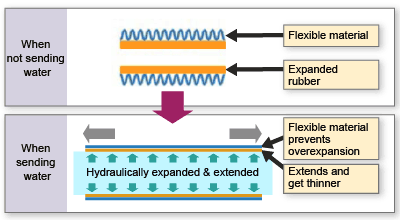Sprinkler hose with a leak
The following shows a case where an extendable sprinkler hose bought four months before became useless with a leak. It was found out that the leak was generated because the inside of the hose got thinner and deteriorated, which caused cracks leading to a cut. The hose was replaced with a new one.
Details of the inquiry
I watched a TV commercial advertising a sprinkler hose (hereinafter called "the hose") which hydraulically extends from 5m to 15m during use. I thought it would be convenient for storage and bought one through the internet. I was using it twice a day, morning and evening, for 15-minute watering of my garden. Four months after, when I was watering the garden, water leaked from the middle of the hose. The hose was hanged from the water tap in the sunny garden each time after use.
I sent an e-mail to the dealer asking for replacement. There is no reply even after 9 days. Since the hose is exposed to high water pressure due to the design of the product, I would like to request a quality test to check if the rubber inside is resistant to the high water pressure.
Product test and survey
After receiving this inquiry, the local consumer center (hereinafter called "the center") requested the National Consumer Affairs Center of Japan (hereinafter called "NCAC") to perform the product test. NCAC found out the following as a result of the test.
(1) Overview of the product under complaint
The product under complaint (Diagram 1) is a hose which is connected to the water tap during use. According to the inquirer, its length is 5m but is hydraulically extended to 15m when used, so it is convenient for storage and carrying around.
The Diagram 2 below shows the status when sending water and names of individual parts. Here, expanded rubber is called "the inside of the hose", and flexible material indicated in blue is called "the outside of the hose".
Diagram 1: Visualization of the product under complaint
Diagram 2: Status when sending water
The flexible material on the outside of the hose extends, which prevents overexpansion. At the same time, the expanded rubber inside the hose gets thinner. The expansion caused by water pressure extends the hose.
(2) Examination of the outside and the water flow
When checking the outside of the hose, no damage or crack was found on the hose and connectors at both ends. However, the outside of the hose did not shrink and remained extended. The length of the product under complaint was 12m and 50cm, while the length of a new product of the same type (bought by NCAC for comparison) was 5m and 15 cm. When touching the outside of the hose under complaint, several cracks were recognized on the inside of the hose (expanded rubber). The position of the cracks was 3m and 35cm from the connector on the sprinkler side and 2m from the connector on the tap side.
The outside of the hose and the caution tag on the connector on the sprinkler side were faded in comparison to the new product of the same type. When we connected the product under complaint to the water tap and turned the tap on, water leaked from the portion of inside cracks to the outside of the hose. The product did not serve a function as a watering hose.
(3) Examination of the inside
When examining the cross-section of the hose under complaint, the thickness of the hose was uneven and partly thinner than the other area. For comparison, we also cut the new product of the same type and found that the thickness of the new product was even and thicker than the product under complaint as a whole. Thickness unevenness of the product under complaint was not local but all over the inside of the hose. There were cracks on the inside of the hose under complaint. The size of cracks was larger in the thinner area than in the other area.
(4) Pressure test
When applying hydraulic pressure twice as much as the average hydraulic pressure of the water supplied in the inquirer's house to the new product of the same type, any crack like the one on the product under complaint was not generated.
(5) Repeated water flow test
When performing a water flow test repeatedly on the new product of the same type which was extended straight, thickness unevenness like on the product under complaint and cracks on the surface were not generated while the inner thickness became thinner.
(6) Test simulating use of bended hose
When sending water through the bended new product of the same type overnight, thickness unevenness was generated and the thickness of the outer side of the bended portion particularly got thinner.
(7) Description
Both the product under complaint and the new product of the same type were supplied with a written instruction and a caution tag attached. The new product of the same type had a written instruction indicating the storage method: "Avoid places with high temperature, high humid and direct sunlight. Keep it in a well-ventilated place" and precautions for use: "Damage on the outside may cause overexpansion inside and explosion. Be sure to check the outside prior to use". However, these messages were not included in the written instruction of the product under complaint. The tag on the hose under complaint was faded and not able to read.
Summarized outcome
The center explained the product test result to the inquirer. The inquirer said, "I have never bent the hose during use. If no problem was found as a result of the repeated water flow test of the new product extended straight, I would like to request replacement of the product with a new one".
The center communicated the dealer the inquirer's request for replacement of the product, explained the product test result and asked for improvement on this problem. The dealer replied that they would use color and material for the tag less subject to fading, try to improve quality of the product, and replace the product under complaint with a new one as requested by the inquirer.
